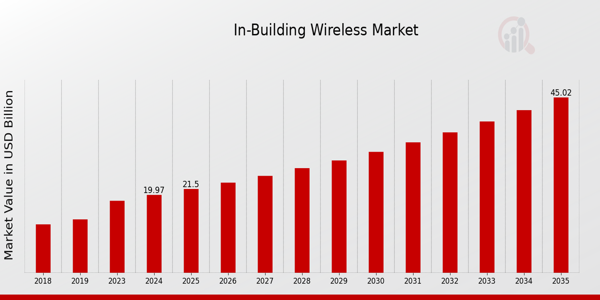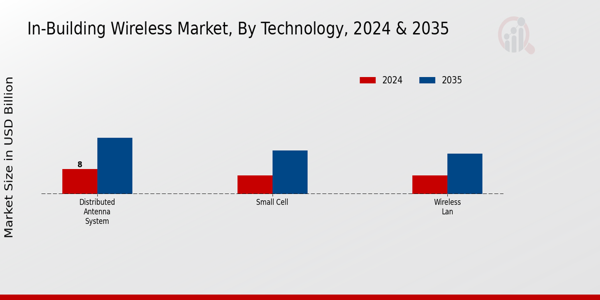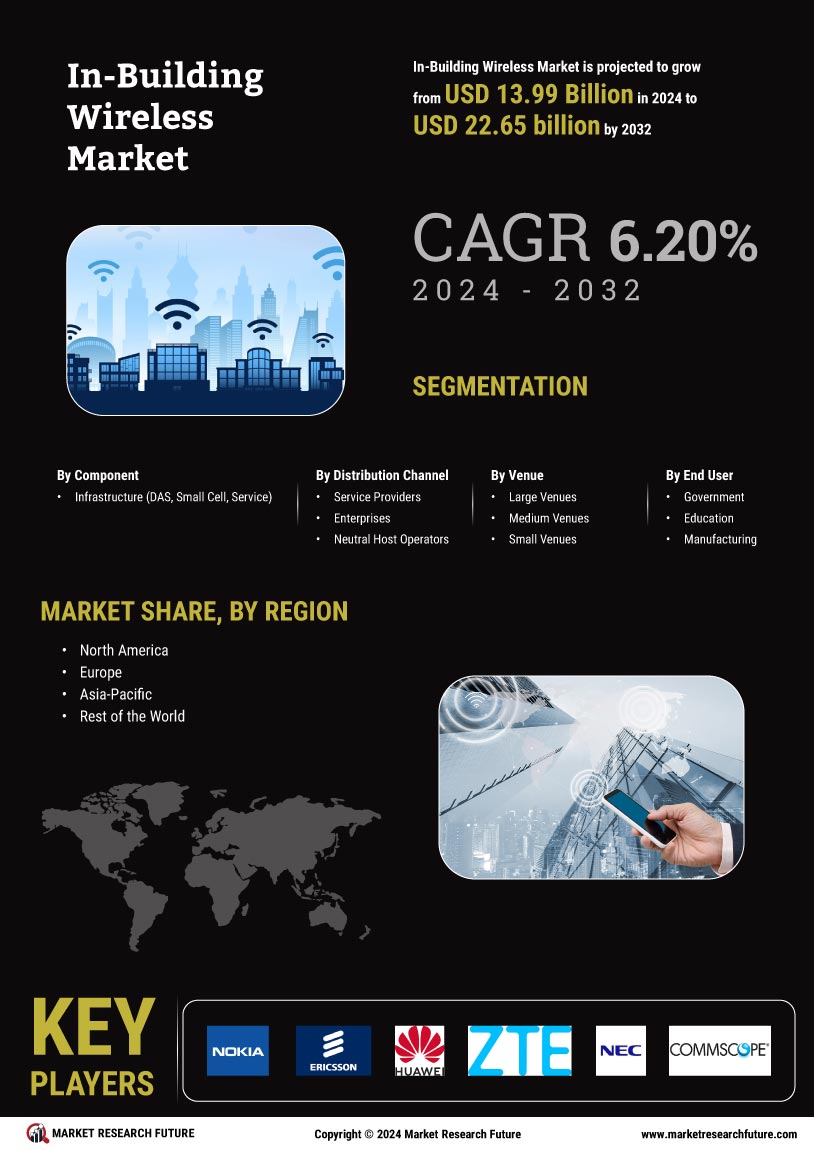In-Building Wireless Market Overview
As per MRFR analysis, the In-Building Wireless Market Size was estimated at 18.55 (USD Billion) in 2023.The In-Building Wireless Market Industry is expected to grow from 19.97(USD Billion) in 2024 to 45 (USD Billion) by 2035. The In-Building Wireless Market CAGR (growth rate) is expected to be around 7.67% during the forecast period (2025 - 2035)
Key In-Building Wireless Market Trends Highlighted
Growing mobile device usage and the arrival of high-bandwidth applications are driving the worldwide in-building wireless market via increasing demand for dependable indoor connection. The need for strong in-building wireless solutions is growing as more companies depend on smooth connectivity for operations and customer interaction. Especially in sectors like healthcare, education, and hospitality, characteristics like high-speed internet, low latency, and good signal quality are increasingly seen, as necessary. The potential prospects might also be seized in the rise of smart building projects and Internet of Things (IoT) technologies needing effective wireless infrastructure.
Presenting a significant chance for businesses offering such solutions, smart buildings use in-building Wi-Fi to optimize operations and increase energy efficiency. Moreover, the transition toward 5G technology provides a new potential, as companies want to improve their in-building systems to meet the higher performance possibilities that 5G networks bring. Latest trends indicate a notable rise in the use of small cells and distributed antenna systems (DAS) as efficient solutions for coverage problems in congested areas. Companies are also searching for reasonably priced options that may be readily incorporated into current infrastructure.
Demand is also being influenced by remote work, as companies understand the need to guarantee constant connection in all settings, whether remote or in-office. Many companies are giving in-building wireless infrastructure top priority as they work to maximize their operations, so investments in this area are gaining worldwide traction. This trend shows the increasing awareness of the requirement of efficient wireless communication as a basic component of contemporary corporate strategy.

Source: Primary Research, Secondary Research, MRFR Database and Analyst Review
In-Building Wireless Market Drivers
Surging Demand for Enhanced Mobile Connectivity
Driven by the rising need for improved mobile connection in metropolitan areas, the Global In-Building Wireless Market Industry is expanding quickly. The Global System for Mobile Communications Association (GSMA) reports a remarkable rise in mobile data traffic, expected to reach 77 exabytes per month worldwide by 2025, indicating a considerable year-on-year increase. Demand is driving companies and building owners to put money into in-building wireless systems to provide continuous connections for employees and consumers.
Demand for in-building solutions is going up to maximize user experiences as companies like Verizon and AT deploy large 5G networks, hence driving market expansion. Every year, more buildings and infrastructure across the world need sophisticated wireless technology as companies work to fit the needs of contemporary, digitally driven surroundings.
Growth of Smart Buildings and IoT Devices
Smart buildings fitted with Internet of Things (IoT) gadgets are greatly changing the Global In-Building Wireless Market Industry. Research by the International Energy Agency (IEA) predicts probable exponential development in smart building technology, with an estimated market increase of 1.5 trillion USD by 2030. Typically, these structures need strong in-building wireless networks as they depend on flawless communication to operate best.
Major companies like Siemens and Honeywell are aggressively pushing smart building solutions, which increases the need for improved in-building wireless solutions to guarantee dependability and speed in connection. Architectural design and technological emphasis provide a solid basis for the expansion of wireless infrastructure in both commercial and residential real estate worldwide.
Regulatory Push for Improved Wireless Infrastructure
Acting as a major force in the Global In-Building Wireless Market Industry, government rules worldwide are pushing for better wireless infrastructure. National telecommunication authorities, like the Federal Communications Commission (FCC) in the United States, have been enacting regulations requiring better communications services for urban and rural communities. Such rules encourage the creation of in-building wireless solutions to satisfy compliance criteria and drive investments.
These changes in regulations are expected to increase the need for in-building systems, driving market expansion. Organizations like the International Telecommunication Union (ITU) are pushing improvements in creating wireless solutions as nations worldwide increase their infrastructure to promote people's access, strengthening the need for these rules.
Increasing Penetration of 5G Technology
The fast introduction of 5G technology is a major growth engine for the global in-building wireless market industry. With more than 100 countries having deployed 5G networks by the end of 2022, the International Telecommunication Union (ITU) has noted significant investment by many countries. This expanded capacity drives the need for integrated in-building solutions to optimize the advantages of 5G technology by enabling users with quicker data speeds and simplified communication.
Telecom firms such as China Mobile and Deutsche Telekom are allocating notable funds to extend 5G coverage inside, thereby boosting sales of in-building wireless equipment. The need for infrastructure supporting 5G becomes increasingly vital as its use spreads worldwide, hence defining a turning point for market expansion.
In-Building Wireless Market Segment Insights
In-Building Wireless Market Technology Insights
The Global In-Building Wireless Market is experiencing significant growth driven by technological advancements and the increasing demand for seamless connectivity within buildings. In 2024, the overall market is projected to be valued at 19.97 USD Billion, reflecting the growing trend towards in-building wireless solutions. Among the various segments of this market, Distributed Antenna System, Small Cell, and Wireless LAN play critical roles. The Distributed Antenna System is anticipated to capture a substantial share, with a market valuation of 8.0 USD Billion in 2024, expected to rise to 18.0 USD Billion by 2035.This growth highlights its crucial role in enhancing mobile coverage in densely populated areas, thereby ensuring reliable wireless communication in environments such as shopping malls, airports, and office complexes.
Small Cell technology, with a value of 6.0 USD Billion in 2024 and projected to reach 14.0 USD Billion by 2035, demonstrates its significance in supporting high-capacity data transfer and alleviating network congestion, which is vital as the number of connected devices continues to proliferate. Wireless LAN, valued at 5.97 USD Billion in 2024 and anticipated to grow to 13.0 USD Billion by 2035, underscores the need for robust wireless networks in organizations that require high-speed internet access for operations and collaboration.The market segmentation reveals that these technologies are essential for addressing the challenges of increasing data consumption and the demand for uninterrupted connectivity in various sectors, including retail, healthcare, and education. As urban areas become more congested and the reliance on wireless communication expands, the Global In-Building Wireless Market will continue to evolve, presenting numerous opportunities for stakeholders amid evolving consumer preferences and technological trends.

Source: Primary Research, Secondary Research, MRFR Database and Analyst Review
In-Building Wireless Market Application Insights
The Application segment of the Global In-Building Wireless Market plays a critical role in shaping the overall growth and development of this industry. By 2024, the market is expected to be valued at 19.97 billion USD, with substantial growth projected leading up to 2035. The retail sector tends to dominate this segment due to the increasing need for seamless connectivity to enhance customer experiences and streamline operations. Additionally, the commercial complex segment is vital, as businesses require robust wireless solutions to support employee productivity and communication.The hospitality industry also significantly contributes by needing reliable wireless networks to improve guest satisfaction and services.
Similarly, the education sector is witnessing growth as institutions increasingly rely on wireless technology to support online learning and administrative functions. Transportation is another key area where in-building wireless solutions are essential for ensuring safety, communication, and operational efficiency. Trends are showing a heightened demand for enhanced connectivity and digital services across these applications, driven by ongoing technological advancements.However, challenges such as infrastructure costs and compatibility issues remain significant barriers. The Global In-Building Wireless Market revenue is expected to reflect the necessity of addressing these challenges while maximizing opportunities across various applications, aligning infrastructure with the evolving communication requirements in a digital age.
In-Building Wireless Market End Use Insights
The Global In-Building Wireless Market is expected to reach a valuation of 19.97 billion USD by 2024, driven by the increasing demand for seamless connectivity in various environments. The End Use segment of this market plays a crucial role, as it is categorized into three main areas: Residential, Commercial, and Institutional settings. The growing reliance on mobile data for everyday activities in both Residential and Commercial spaces, including shopping malls, offices, and residential complexes, highlights the importance of robust wireless solutions.Institutional environments, such as schools and hospitals, further necessitate reliable wireless communications to ensure safety and efficiency. The demand for enhanced services, enabled by the Internet of Things and smart technologies in these sectors, has significantly boosted the relevance of the In-Building Wireless Market.
Moreover, with the expansion of urban areas and the increasing number of multi-story buildings, the need for effective wireless solutions is anticipated to grow steadily, aligning with the Global In-Building Wireless Market statistics that predict strong growth in the coming years.The integration of advanced technologies, coupled with government initiatives to promote digital infrastructure, supports the ongoing evolution of this market segment, emphasizing its vital role in future development.
In-Building Wireless Market Connectivity Type Insights
The Global In-Building Wireless Market, particularly concerning the Connectivity Type segment, is experiencing significant growth. By 2024, the market is expected to be valued at 19.97 USD Billion, reflecting the increasing demand for reliable wireless connectivity in urban environments and commercial spaces. The segment encompasses various connectivity types which cater to different industry needs. Among these, 4G and Wi-Fi remain dominant due to their widespread adoption and capability to support high data transfer rates, essential for business operations and consumer demands.The emergence of 5G technology is becoming increasingly significant in enhancing connectivity within buildings, offering substantially higher bandwidth, low latency, and the ability to connect a larger number of devices concurrently, which is crucial for smart building implementations.
Additionally, LoRa technology offers advantages in low-power communication, making it suitable for IoT applications in large facilities, while Private LTE is gaining traction among enterprises seeking secure and dedicated communication networks for critical operations.The evolving landscape indicates that a blend of these technologies will drive growth in the Global In-Building Wireless Market, ultimately improving connectivity solutions for various sectors.
In-Building Wireless Market Regional Insights
The Global In-Building Wireless Market is witnessing robust growth across various regions, fueled by the increasing demand for seamless connectivity and mobile access within buildings. In 2024, the North America segment commands a significant share, valued at 8.0 USD Billion, and is projected to grow to 18.0 USD Billion by 2035, due to advanced infrastructure and high penetration of smartphones. Europe follows closely with a valuation of 6.0 USD Billion in 2024, expected to reach 13.5 USD Billion by 2035, largely driven by the rise of smart buildings and stringent government regulations.The Asia-Pacific (APAC) region, valued at 4.0 USD Billion in 2024 and 10.0 USD Billion in 2035, shows promising growth prospects, propelled by urbanization and increasing investments in telecommunications infrastructure. South America, although smaller with a valuation of 1.5 USD Billion in 2024 and 2.5 USD Billion by 2035, is gradually expanding due to improving telecommunications services.
Meanwhile, the Middle East and Africa (MEA), valued at 0.47 USD Billion in 2024 and expected to increase to 1.0 USD Billion by 2035, has significant growth potential as the region focuses on infrastructure development and technological advancements.This diverse regional segmentation illustrates the varying pace of growth, with North America dominating the market. Each region presents unique opportunities and challenges influenced by local conditions, regulatory frameworks, and technological advancements within the Global In-Building Wireless Market industry.

Source: Primary Research, Secondary Research, MRFR Database and Analyst Review
In-Building Wireless Market Key Players and Competitive Insights
The Global In-Building Wireless Market has evolved into a critical space, driven by increasing wireless communication demands and the need for seamless connectivity indoors. The landscape is characterized by advanced technologies, diverse solutions, and a variety of product offerings tailored for improving mobile coverage and capacity within buildings. As organizations recognize the importance of reliable wireless communications for both enterprise and consumer experiences, competitive players are striving to innovate and refine their offerings. The entry of new technologies like 5G has further intensified competition as companies seek to provide enhanced performance, flexibility, and scalability for diverse indoor environments.
JMA Wireless stands out in the Global In-Building Wireless Market with a strong emphasis on robust connectivity solutions. The company's portfolio features advanced Distributed Antenna System (DAS) solutions and end-to-end network offerings that address diverse communication needs across various sectors such as education, healthcare, and hospitality. JMA Wireless has earned a solid reputation for delivering high-performance systems that are easy to deploy and manage, establishing a strong market presence in multiple regions. Their commitment to RD enables them to stay ahead of industry trends, offering innovative technologies that provide enhanced indoor coverage and capacity. Strengths include a proactive approach to customer service and a focus on customization, allowing them to better meet the unique demands of clients in an evolving wireless landscape.Corning is a key player in the Global In-Building Wireless Market, recognized for its comprehensive solutions that facilitate effective wireless communication in complex environments. The company's offerings include fiber optic solutions and intelligent wireless networks that enhance connectivity within commercial buildings.
Corning’s strengths lie in its extensive portfolio, including the Corning Optical Network Solution and various DAS technologies that promote high-quality signal distribution. Their strategic focus on mergers and acquisitions ensures a continuous effort to enhance product capabilities while expanding their market reach. This includes partnerships and collaborations that help integrate their solutions into existing infrastructures seamlessly. Corning has successfully established itself as a trusted provider for clients seeking cutting-edge technology, bolstered by a consistent track record of reliability and innovation in the Global In-Building Wireless Market.
Key Companies in the In-Building Wireless Market Include
- JMA Wireless
- Corning
- MobiWire
- Airgain
- SOLiD
- ZTE
- Teoco
- Bird Technologies
- SpiderCloud Wireless
- Cisco Systems
- CommScope
- Qualcomm
- Ruckus Networks
- Nokia
- Ericsson
In-Building Wireless Market Industry Developments
Recent developments in the Global In-Building Wireless Market have highlighted the increasing demand for seamless connectivity in commercial spaces. Companies like JMA Wireless and Corning continue to innovate with advanced Distributed Antenna Systems (DAS) and small cells aimed at enhancing wireless coverage indoors. In terms of acquisitions, Qualcomm made headlines in September 2023 with its acquisition of a notable technology firm, strengthening its position in the wireless domain. Airgain has reported significant growth in its market valuation, reflecting a shift towards higher demand for in-building solutions fueled by escalating mobile data consumption. SOLiD and Cisco Systems have also expanded their market reach by forming strategic partnerships and enhancing product portfolios.
The market is gaining traction, with substantial investments being funneled into research and development initiatives across leading companies like Ericsson and Nokia, focusing on next-generation wireless technologies. In the last two years, significant changes such as the adoption of 5G solutions, with major deployments noted in Q2 2022, have transformed connectivity dynamics in large venues worldwide, fueling the growth of the in-building wireless segment and encouraging competition among key players in the global landscape.
In-Building Wireless Market Segmentation Insights
- In-Building Wireless Market Technology Outlook
- Distributed Antenna System
- Small Cell
- Wireless LAN
- In-Building Wireless Market Application Outlook
- Retail
- Commercial Complex
- Hospitality
- Education
- Transportation
- In-Building Wireless Market End Use Outlook
- Residential
- Commercial
- Institutional
- In-Building Wireless Market Connectivity Type Outlook
- 4G
- 5G
- Wi-Fi
- LoRa
- Private LTE
- In-Building Wireless Market Regional Outlook
- North America
- Europe
- South America
- Asia Pacific
- Middle East and Africa
| Report Attribute/Metric Source: |
Details |
| MARKET SIZE 2023 |
18.55(USD Billion) |
| MARKET SIZE 2024 |
19.97(USD Billion) |
| MARKET SIZE 2035 |
45.0(USD Billion) |
| COMPOUND ANNUAL GROWTH RATE (CAGR) |
7.67% (2025 - 2035) |
| REPORT COVERAGE |
Revenue Forecast, Competitive Landscape, Growth Factors, and Trends |
| BASE YEAR |
2024 |
| MARKET FORECAST PERIOD |
2025 - 2035 |
| HISTORICAL DATA |
2019 - 2024 |
| MARKET FORECAST UNITS |
USD Billion |
| KEY COMPANIES PROFILED |
JMA Wireless, Corning, MobiWire, Airgain, SOLiD, ZTE, Teoco, Bird Technologies, SpiderCloud Wireless, Cisco Systems, CommScope, Qualcomm, Ruckus Networks, Nokia, Ericsson |
| SEGMENTS COVERED |
Technology, Application, End Use, Connectivity Type, Regional |
| KEY MARKET OPPORTUNITIES |
5G network deployment, Integration with IoT technology, Increasing demand in urban areas, Enhanced user experience solutions, Smart building initiatives |
| KEY MARKET DYNAMICS |
growing demand for seamless connectivity, increasing smartphone penetration, rise in IoT devices, need for 5G infrastructure, regulatory support for wireless solutions |
| COUNTRIES COVERED |
North America, Europe, APAC, South America, MEA |
Frequently Asked Questions (FAQ) :
The Global In-Building Wireless Market is expected to be valued at 45.0 USD Billion by 2035.
The expected CAGR for the Global In-Building Wireless Market from 2025 to 2035 is 7.67%.
North America is expected to have the largest market share, projected at 18.0 USD Billion by 2035.
The market size for Distributed Antenna System is expected to reach 18.0 USD Billion by 2035.
The expected market value for Wireless LAN is projected at 13.0 USD Billion by 2035.
The APAC region is projected to reach a market size of 10.0 USD Billion by 2035.
Key players in the market include JMA Wireless, Corning, MobiWire, and Cisco Systems among others.
The market size for Small Cell technology is expected to be 14.0 USD Billion by 2035.
Europe's market value in the Global In-Building Wireless Market is projected to be 13.5 USD Billion by 2035.
The market may face challenges related to technological advancements and regulatory requirements.

















